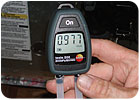
The high external static pressure on this furnace is not
good. However, the a/c airflow is still almost 400 cfm per ton. Why?
David turned the a/c on and offered to teach John and Charlie the basics of measuring and interpreting static pressure and return grille velocity.
“While duct leakage is usually the biggest problem, there are often other issues,” said David. “Measuring static pressure is a fundamental part of diagnosing how a duct system is performing. It’s kind of like getting your blood pressure tested when you go to the doctor.”
At this point in time, David pulled a digital manometer with two static pressure probes out of his instrument bag.
“So, John,” said David, speaking loudly to be heard over the air noise made by the furnace fan, “you’ve been installing systems for quite a while. Where do you normally stick the probes to measure the external static on a furnace when you commission a new system?”
John was embarrassed to admit that he wasn’t really sure.
“You know, that isn’t something we actually do,” said John. “I know we should, but with the pressure to get the job done and on to the next one …”
He shrugged and took a stab at the question: “I guess we should put one into the supply plenum?”
“Well,” answered David, “we will also take a measurement there, but that’s not actually the starting point.”
PROPER DRILLING
David informs his techs that when measuring the external static on a furnace, one needs to take readings right at the inlet and the outlet of the furnace.“That’s how the manufacturers test them in the lab,” he said.
“In this case, for the supply side, we need to be here, between the furnace and the external cased coil. That way we will include the resistance caused by pushing air through the a/c coil, as well as the supply ducts.”
If you just measure above it in the plenum, he said, you won’t take the coil into account, and “you’ll really misinterpret what’s going on.”
“OK,” answered John. “So we have to be before the coil. But how? There’s no transition to drill into.”
“That’s true, and it is a challenge,” said the field trainer. “We try to avoid drilling into the coil case. You never want to hear that dreaded hissing sound … or put a hole in the drain pan!
“While it’s not ideal, the best solution in the field is usually to drill here through the side of the furnace cabinet, just below its outlet. It’s not perfect, but Charlie, could you pop a hole in right here? Use a quarter inch bit, with this stop to keep the bit from doing more than just piercing the cabinet.
“While you’re at it, go ahead and also drill another hole up here in the supply plenum, downstream of the coil, so that we can later measure the resistance caused by the coil itself.”
While Charlie prepared his cordless drill, David put John on the spot again.
“So now that you know the overall principle, where should we put the measurement hole on the return side of the furnace?” asked David, pointing down to where the furnace was sitting on a new Aprilaire filter base.
John thought for a moment.
“Hmmm,” he finally said. “You said we should measure external static right at the inlet and outlet of the furnace. But there’s a filter in the way and no transition, just like there was a coil in the way on the supply side. Do we need to make a hole in the furnace again?”
David agreed that was one possible option.
“One could go in here through the front of the blower compartment. Or, if you can go through the filter cabinet, that’s often better, as long as you are on the furnace side of the media,” said David. “We’ll also drill a hole through the plywood platform into the return plenum so we can measure the drop across the filter.”
HIGH BLOOD PRESSURE IN YOUR DUCTS
Once the holes were drilled, John inserted the probes to measure the external static pressure on the furnace. The supply side was 0.28 inches; the return was 0.70 inches. Putting both probes in place, the total was a whopping 0.98 inches.“Wow!” he exclaimed, looking over to David. “Isn’t half an inch the maximum you’re supposed to have? We can’t be moving the right amount of air against that high a static! It must be running really low on air. What do you think … maybe only 250 cfm/ton?”
John glanced nervously over his shoulder to make sure the homeowner wasn’t listening in on the conversation.
“Actually, it probably is moving the right amount of air,” corrected David. “The half-inch rule of thumb is only that, a rule of thumb. There are actually many exceptions. What we’re seeing here sure isn’t good, but it’s not as bad as it seems.”
In an upcoming issue:Find out how a system running at almost 1 inch of static can still deliver the right airflow, how sealing the ducts contributed to the high static, and what still needs to be done to make this system work properly.
Publication date:06/11/2007

Report Abusive Comment